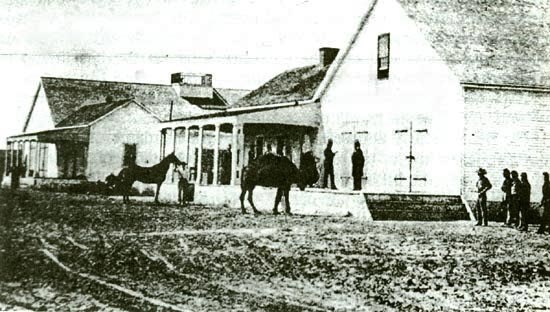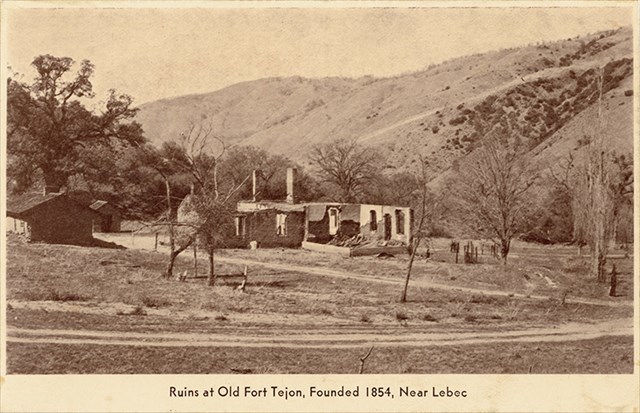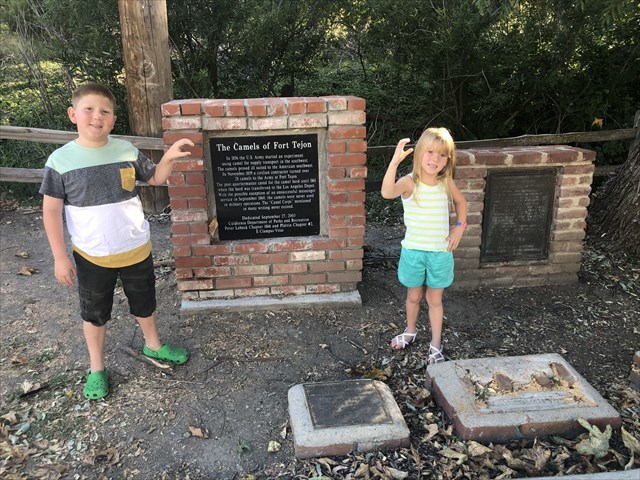The Camels of Fort Tejon
At Fort Tejon, camels were NOT an essential element of the Fort's history. Camels were at the Fort for only 5-1/2 months, from Nov. 17, 1859 to mid April 1860. The camels were never used by the soldiers at Fort Tejon. They were government property and were kept here only a short time during the winter of 1859/60 before being moved to the Los Angeles Quartermaster Depot on their way to Benicia where they were auctioned off at a loss to the Government in 1864.

Loading a Bactrian camel onboard ship in Turkey - Sketch by G. H. Heap, National Archives
Fort Tejon was never any "Terminus" for the camels. There was never a "U.S. Camel Corps" as has been stated by so many authors; it was just an experiment. E.F. Beale was a civilian under contract to survey a road from New Mexico to California by the U.S. Government. He was never in command of Fort Tejon, the camels or any soldiers.
The camels have been one of the greatest myths and legends of Fort Tejon's past. The story is great and many writers have latched on to it. It is fascinating fodder for western lore, but most stories about this interesting experiment have little grounding in fact. Unfortunately, many writers are perpetuating these myths and rely on the early authors that wrote in the 1920s to 1960s who based their research and assertions on non-historical methods.
Source and excellent additional reading: Fort Tejon Historical Association THE MYTHICAL FORT TEJON "CAMEL CORPS" by George Stammerjohn

The only known photograph of an Army camel. Government Depot near Banning's Wharf.
If you happen to be driving along the I-10 in Quartzsite, Arizona, be sure to check out a sister virtual of sorts named HI JOLLY that is a memorial for the camel driver Hadji Ali.
Fort Tejon History
Fort Tejon in California is a former United States Army outpost which was intermittently active from June 24, 1854, until September 11, 1864. It is located in the Grapevine Canyon (La Cañada de las Uvas) between the San Emigdio Mountains and Tehachapi Mountains. It is in the area of Tejon Pass along Interstate 5 in Kern County, California, the main route through the mountain ranges separating the Central Valley from the Los Angeles Basin and Southern California. The fort's location protected the San Joaquin Valley from the south and west.
The fort's mission was to suppress stock rustling and protect settlers from attacks by discontent Californios (pre-statehood residents), and Native American tribes, including the Paiute and Mojave, and to monitor the less aggressive Emigdiano living nearby. The Emigdiano, who were closely related to the Chumash of the coastal and interior lands to the west, had several villages near Fort Tejon. After the earlier Spanish and Mexican colonial Indian Reductions, they were generally cooperative with the European-American settlers and the U.S. Army.
At the urging of Edward Fitzgerald Beale, Superintendent of Indian Affairs in California, the U.S. Army established Fort Tejon in 1854. Fort Tejon was the headquarters of the First U.S. Dragoons until those Regular Army troops were transferred to the East in July 1861 soon after the outbreak of the American Civil War. The fort was re-occupied by California volunteer troops in 1863. Those units included Companies D, E and G of the 2nd California Volunteer Cavalry from July 6 to August 17, 1863; and Company B of the 2nd California Volunteer Infantry, which remained there until Fort Tejon was abandoned for good on September 11, 1864.
Source: Fort Tejon Wikipedia Page

Ruins at Old Fort Tejon, Founded 1854, Near Lebec, CA
Fort Tejon State Historic Park
Fort Tejon is located in the Grapevine Canyon, the main route between California's great central valley and Southern California. The fort was established to protect and control the Indians who were living on the Sebastian Indian Reservation, and to protect both the Indians and white settlers from raids by the Paiutes, Chemeheui, Mojave, and other Indian groups of the desert regions to the south east. Fort Tejon was first garrisoned by the United States Army on August 10, 1854 and was abandoned ten years later on September 11, 1864.
There are restored adobes from the original fort and the park’s museum features exhibits on army life and local history. The park also has a number of beautiful 400 year-old valley oak trees.
Park Grounds Open Sunrise to Sunset - Park Open 9-4 Daily - Interpretive Exhibits Open 9-4 Daily
Day Use Fees: Child (0-6) Free - (7-17) $1.00 - Adult (17 and up) $3.00
Source: Fort Tejon SHP Page

Parade ground at Fort Tejon, California, June 2006.
Logging Requirements
In order to log this virtual cache, you must take a photo of yourself in front of the various camel historical plaques and make a C with your hand. If you do not wish to have your face in the photo, then you must post a photo of your hand holding up a C or a sign that says, "I visited the Camels of Tejon and all I got was this lousy sign, which I had to bring myself." Any found it logs without photo evidence will be deleted. e-mailed or messaged photos do not count, so the photo must be posted on your log. If you take a while to upload photos, you should mention that in your log. Any logs without photos uploaded in a month may be deleted without warning. Thank you and happy caching!

Sample required logging photo with faces shown

Sample required logging photo with no faces shown
The Historic 40 Stage Multi-Cache
Did you know this is also a stage for The Historic 40 Stage Multi-Cache? So while you are here, please feel free to check out Stage 38 "The Camels of Fort Tejon" and see what is required and make note of it just in case you ever want to complete what is probably the largest stage multi-cache in California. Let us know if you know of one larger!
And don't forget to check out my other quality Geocaches within 5 miles of here. They have great entertainment, historical, and clever Geocaching content!
Virtual Rewards 2.0 - 2019/2020
This Virtual Cache is part of a limited release of Virtuals created between June 4, 2019 and June 4, 2020. Only 4,000 cache owners were given the opportunity to hide a Virtual Cache. Learn more about Virtual Rewards 2.0 on the Geocaching Blog.